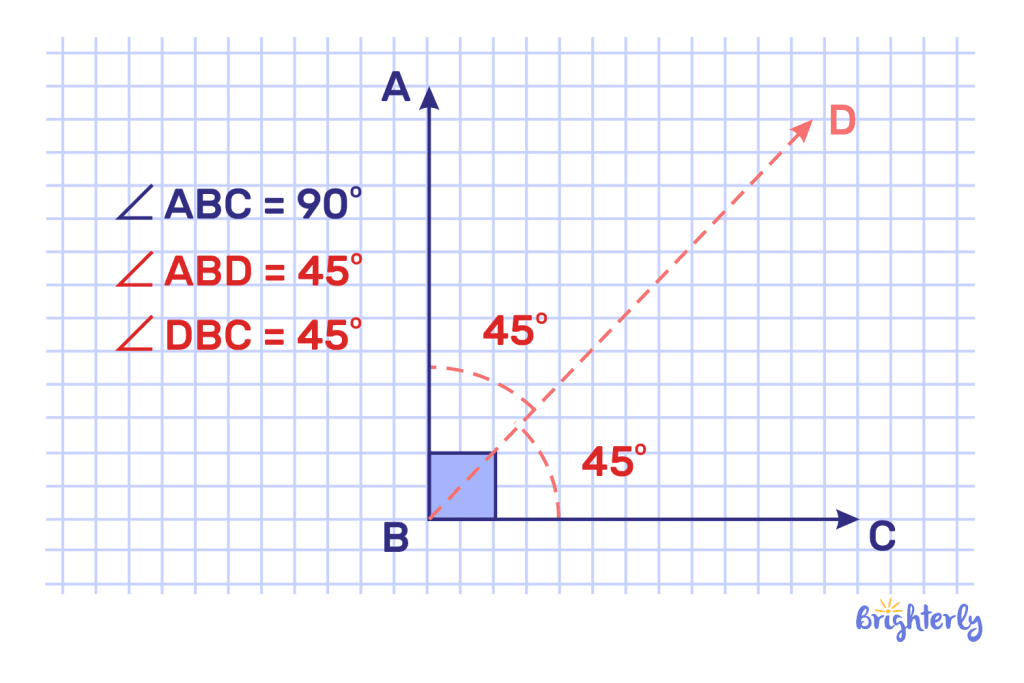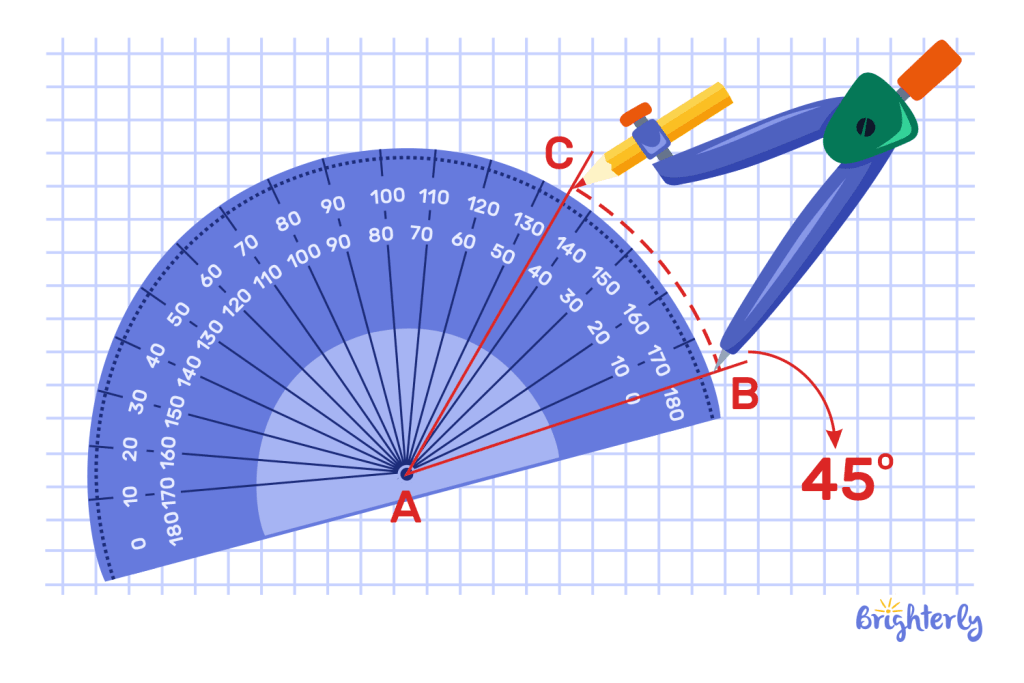45-Degree Angle – Definition with Examples
Updated on November 29, 2025
Brighterly is on yet another thrilling journey to help students understand, enjoy, and find meaning in math. Today, we are exploring the 45-degree angle in geometry.
There are many shapes that can be built with a 45 degree angle, but a 45 degree angle is a fundamental building block that inspires imagination and curiosity. In Brighterly, we want to show students how meaningful and useful this math concept is. They will learn to draw it with simple tools and see it around them in daily life. Let’s explore the fascinating 45 degree angle together.
What is 45 degree angle?
A 45 degree angle appears when a right angle is divided into two equal parts, each of which is 45 degrees. A 45 degree angle is referred to as an acute angle since it is smaller than a right angle. Put differently, a 45 degree angle is equal to half of a 90 degree angle.
Look at this 45 degree angle picture. You will see that the 45 degree angle is formed by two equal parts of a right angle. It is important to understand 45 degrees angle in order to understand shapes, geometry, and other aspects of our world.

45 degree angle construction
To create a 45° angle, students use a protractor and a compass — relatively straightforward tools. Speaking broadly, any aspiring geometer needs these two tools to construct precise angles, beyond the 45 degree angle. With just a few simple steps, anyone can create accurate 45 degree angles and see how they appear in real-world designs.
Сonstruction of 45 degree angle using a protractor
A protractor is a half-circle tool used to measure and draw angles. To make a 45° angle, put one side of your line along the protractor’s zero line. Make a small mark on the curved edge where 45 is. Place the protractor on the corner (the vertex) of your angle. A 45 degree angle is created by drawing a line from the corner to the dot.
Constructing 45 degree angle with a compass
You can also make a 45° angle using a compass — another helpful tool in geometry. After drawing a straight baseline, place the compass on each crossing point and make two more arcs above the line without changing the compass width. Draw a line from the base point to where the arcs meet — this line makes a 45 degree angle.

One of the lines is halfway between the two perpendicular directions when perpendicular lines form a 45° angle. This method takes a bit more practice than using a protractor, but it helps children understand geometry better.
45 degree angles in real life
A 45 degree angle isn’t just a math idea — it’s something we see every day! From buildings to art, this special angle helps create balance, strength, and beauty. Here are some common 45 degree angle examples you can spot around you:
- The slope of a roof or ramp
- The steps of a staircase
- The corner of a folded paper airplane
- The open screen of a laptop
- The diagonal of a square or picture frame
- A golf ball or basketball launched at the best angle for distance
- The blades of scissors, when partly open
Curious to learn more? If you’re wondering what is a 45° angle, noticing these real-life examples is a perfect place to start. Designers, architects, and even athletes use 45 degree angles to make things work better or look more balanced. Once you start paying attention, you’ll find 45 degree angles almost everywhere — at home, at school, and outside!
Practice problems on 45 degree angle
- Draw a 45° angle. Using a protractor, draw a 45 degree angle on a piece of paper. When working with your child, ask them something like, “Show me a 45° angle by folding the paper in half along a right angle.”
- Spot the angle. Look around your room or outside. Can you find three objects that have a 45 degrees? Examples might include a ramp, the corner of a picture frame, or the slope of a roof.
- Build with paper. Take a square piece of paper. Fold one corner so that it meets the opposite side to create a triangle. What angle do you see at the folded corner? Hint: it should be a 45 degree angle.
- Right triangle fun. Draw a right triangle (one angle is 90). If one of the other angles is 45 degrees, what is the measure of the remaining angle?
Conclusion
45 degree angles are more than just numbers on a page — they are shapes we see all around us. Kids gain confidence in geometry and practice critical abilities like accuracy and observation by learning 45 degree angles, which they can use for building, drawing, sports, and everyday items. The fact that we can see 45 degree angles in the real world shows that geometry is not just a concept on paper, but a part of our everyday lives.
Frequently asked questions on 45 degree angle
What is a 45 degree angle?
A 45 degree angle is an acute angle that is exactly half the size of a right angle. It has a variety of shapes, including squares and triangles, and is smaller than ninety.
What does a 45 degree angle look like?
A 45 degree angle looks like a sharp, slanted corner that is half of a right angle. For example, imagine cutting a square in half diagonally. 45 degree angles tend to be symmetrical and are easy to spot in shapes, objects, and designs.
How to find a 45 degree angle?
To find a 45 degree angle, use a protractor to measure 45 degrees, if you have a curved edge; if you have a compass, draw arcs to create a 45 degree angle.
Where can I see 45 degree angles in real life?
There are 45 degree angles in everything from roofs and ramps to stairs and picture frames to basketball throwing for maximum distance. They are used by athletes, designers, and architects to produce accuracy, strength, and balance.






